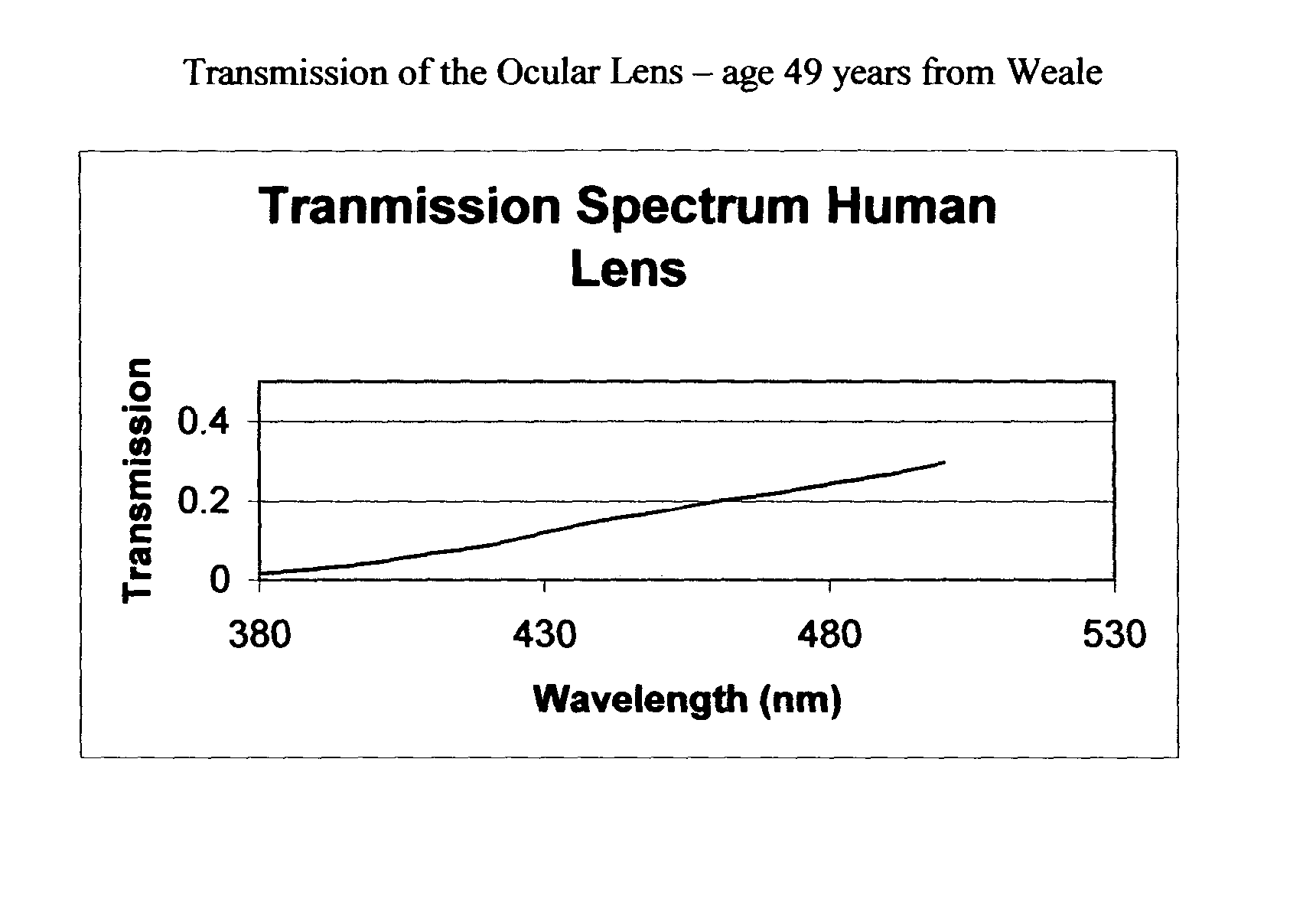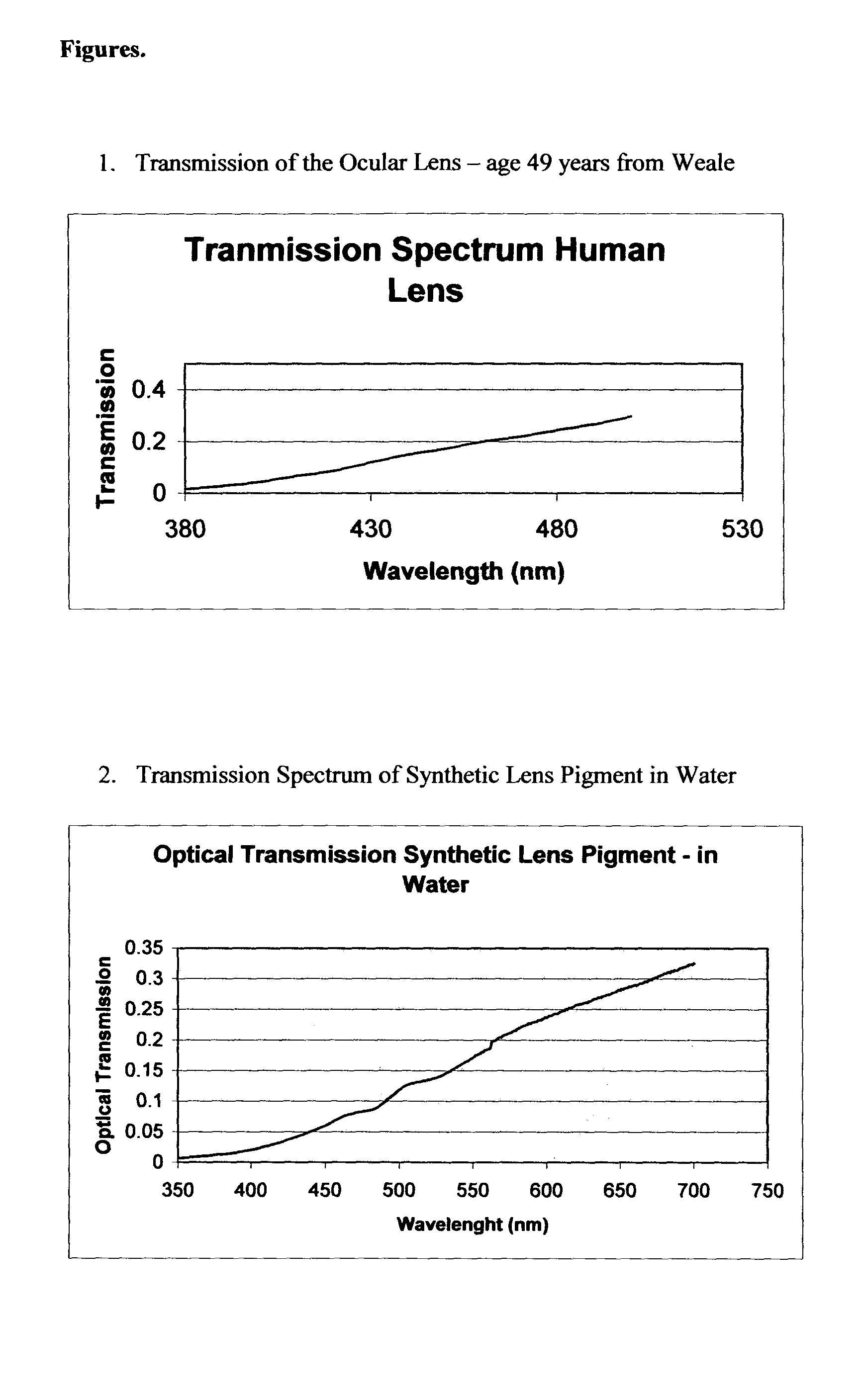Light filters using the oxidative polymerization product of 3-hydroxykynurenine (3-OHKyn)
a technology of hydroxykynurenine and light filter, which is applied in the field of eye protection and vision enhancement, can solve the problems of color distortion and loss of color perception, and achieve the effects of reducing light pollution, increasing contrast and visual acuity, and recognizing the importance of hev light reduction
- Summary
- Abstract
- Description
- Claims
- Application Information
AI Technical Summary
Benefits of technology
Problems solved by technology
Method used
Image
Examples
example 1
[0042] The oxidative polymerization product of 3-hydroxykynurenine was acidified and dispersed in THF and dried over sodium sulphate. In order to achieve pigment dispersability and solubility in CR39 plastic monomer, the synthetic lens pigment, SLP, was dertivatized with methylchloroformate as follows: 5 cc of pyridine was added to 30 cc of THF containing 4 g of SLP. Then 8 cc of methylchloroformate was added dropwise over a period of 10 minutes and stirred for 5 hours. The product was filtered and the washed 3 times with equal volumes of deionized water. The product was dried over sodium sulphate for 24 hours and then injected into hexane and dried to a powder
[0043] 0.3 g of the powder was dissolved into 100 cc of liquid CR39 monomer and the solution was heated to 50 degrees C. Then 3 g of benzoyl peroxide was added and the solution was stirred until all of the benzoyl peroxide was dissolved. The temperature was increased to 60 and some of the solution was injected into a mold for...
example 2
[0046] 0.2 g of SLP powder was mixed with 120 g of acrylic pellets and compounded being heated under pressure, causing the SLP to be uniformly blended with the acrylic plastic. The products was injected into flat test plates yielding a clear, yellow-brown “lens” with a transmission spetrcum as shown in FIG. 5.
[0047] Another method for incorportating the SLP product into optical lenses is by dispersing it in polyvinyl alcohol (PVA). PVA films may be bound to thin, rigid sheets of other plastics to provide mechanical intergrity to the flexible PVA film. These laminates may then be inserted into lens molds to produce piano and Rx lenses in either a thermoplastic process or in a thermoset process. While this method is less commonly used in the production of optical lenses, it has the advantage of using aqueous based SLP
example 3
[0048] To an aqueous solution of 0.4 g SLP in 100 cc of deionized water was added 2.0 g of PVA powder and heated to 95 degrees C. while stirred. After all of the PVA powder dissolved in the SLP / water system, the solution was allowed to cool to about 50 degrees C. and approximately 2 cc of the black solution was deposited onto a thin, flat sheet of glass. After the water fully evaporated, a thin, brown-colored PVA film was formed on the glass surface.
[0049] A transmission spectrum of the PVA / SLC film is shown in FIG. 6.
[0050] From the foregoing description, the principal advantages of using the yellow ocular pigment or its synthetic version made from the polymerization of 3-hydroxyKynurenine, as an absorbing pigment in a media for radiation protection are: [0051] 1. The transmission of light by SLP decreases progressively as the energy of the light increases, and therefore as the potential for photooxidation increases. [0052] 2. The human vision system is accustomed to the transmis...
PUM
| Property | Measurement | Unit |
|---|---|---|
| volume | aaaaa | aaaaa |
| volume | aaaaa | aaaaa |
| concentration | aaaaa | aaaaa |
Abstract
Description
Claims
Application Information
 Login to View More
Login to View More - R&D
- Intellectual Property
- Life Sciences
- Materials
- Tech Scout
- Unparalleled Data Quality
- Higher Quality Content
- 60% Fewer Hallucinations
Browse by: Latest US Patents, China's latest patents, Technical Efficacy Thesaurus, Application Domain, Technology Topic, Popular Technical Reports.
© 2025 PatSnap. All rights reserved.Legal|Privacy policy|Modern Slavery Act Transparency Statement|Sitemap|About US| Contact US: help@patsnap.com



